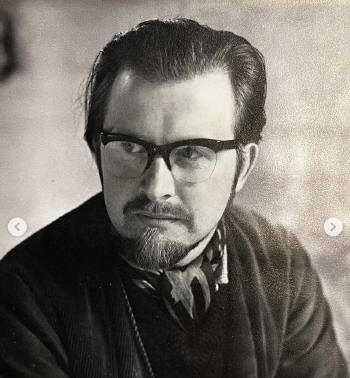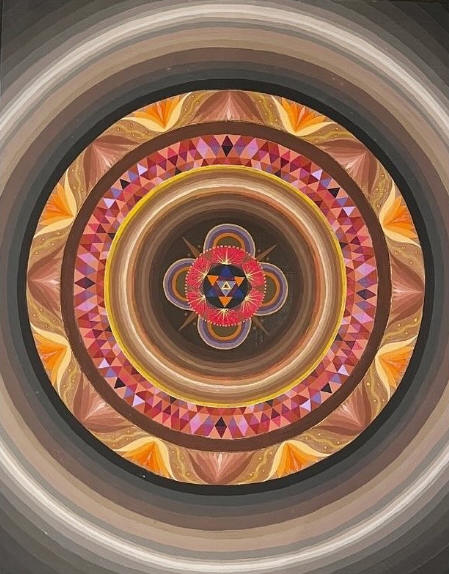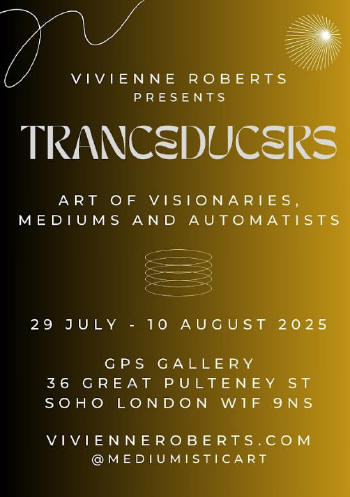|
|
| home | exhibitions | interviews | features | profiles | webprojects | archive |
|
Victor Bramley: An Unexpected Journey Vivienne Roberts for the occasion of the exhibition: 'Tranceducers: Art of Visionaries, Mediums and Automatists' at the GPS Gallery, Soho, London. July 29th to August 10th 2025.
“I spent many weekends tramping the hills and dales, camping or sleeping rough, scrambling through caves and potholes, and climbing the gritstone edges,” he recalled. The acquisition of a bicycle gave him even greater freedom, allowing him to criss-cross much of England and Wales. Rejecting the family butcher’s business, Victor instead worked for the Forestry Commission, but the appeal of the open road soon beckoned. His travels took him to London and the South East, where he embraced a nomadic lifestyle and joined travelling communities. Each time funds ran low, he would return to Sheffield to regroup and plan his next adventure. His wanderlust also led him further afield to France, Spain, and Italy, where he delighted in “camping wild and absorbing the dramatic and magnificent landscape.” In 1959, he arrived in St Ives, drawn by its vibrant artistic community. He found work washing dishes at Curnow’s Hotel, where he met Jacque Moran, the popular receptionist and former partner of artist Sven Berlin who was well-versed in the local art scene. Recognising Victor’s raw talent, Jacque encouraged him to pursue his dream of becoming an artist. The two married in 1960. Gradually, recognition of Victor’s skill in painting landscapes and still-life compositions began to emerge, despite what he felt was a seemingly impenetrable art world. He joined the Sail Loft Studios before setting up his own studio on Tregenna Hill. In 1961, he was elected a member of the St Ives Society of Artists, remaining a loyal and active member for sixty years. His work featured in numerous exhibitions at the Mariner and Crypt Galleries, the Newlyn Society, the Penwith Society, and at 36 Fore Street, where he exhibited alongside such luminaries as Ben Nicholson, Barbara Hepworth, Wilhelmina Barns-Graham, Terry Frost, and Peter Lanyon. Although in awe of this remarkable artistic milieu, Victor remained proud of his autodidactic path. Entirely self-taught, he valued his independence from formal training and artistic constraints: “Being self-taught and self-empowered, I feel that I have always had the freedom to paint how and what I want—and not have to prove myself to anyone.” In 1964, Victor and Jacque moved to Nancledra, a village nestled between St Ives and Penzance, where Victor used the village mill as his studio. The peaceful, bucolic environment suited him perfectly. In 1967, he began practicing Kundalini yoga and meditation—disciplines that sparked a radical transformation in his art. Immersing himself in books on Eastern art, philosophy, religion, and yoga, Victor began creating intricate mandala drawings and paintings. His spiritual journey expanded to include divination practices such as the I Ching, runes, and tarot, and he became adept at constructing astrological charts for clients, even offering healing sessions. His endlessly curious mind also led him to join the Penzance UFO Society. These explorations into the esoteric and metaphysical are reflected in the titles of many of his works, including Ad Astra, Aura, Planetary Inferences, and Astral Suspension. The paranormal soon became a shared way of life for the Bramleys. Jacque, too, began having profound visionary experiences, which she believed were being channelled into Victor’s mandala paintings. Jacque described it as working in a kind of telepathic harmony, guided by unseen forces. The deeply personal and spiritual nature of these works meant that they were often difficult to part with, especially for Jacque, who was known to actively discourage the sale of Victor’s paintings. Financial necessity eventually compelled Victor to take a job with the St Ives postal service. Though grateful for the stability it provided, he mourned the lost studio time and the paintings that were never realised. For Victor, time to study and deepen his spiritual practice was not separate from his art, it was integral to his creative process, as he reflected: "I drew designs in the garden on a sunny afternoon - as I worked a bee landed briefly on both pages stopping only to extend its proboscis. I carried on working and then it occurred to me to ask why it landed here. If you follow the arrow to the landing point - the reason becomes obvious. So does a striking pattern attract the bee even without the incentive of colour and scent? Surely the spirit is drawn to the mandala in much the same way - hoping for nectar from the flower. The bee of course doesn’t know that - as it collects its food it pollinates the flower which will then bear fruit for others to eat and fertilise the plant to produce more of its kind. I wonder what unknown fruits are brought forth or what hidden growth is nourished when a spirit comes to dwell on a mandala?" 17th July 1974 Fortunately, a remarkable series of mandala works emerged during the 1970s, catching the attention of trailblazing curator John Halkes. In 1974, he invited Victor to exhibit them for the first time at The Orion Gallery. That same year, the gallery amalgamated with the nearby Newlyn Gallery, where Ithell Colquhoun, a fellow member of Penzance UFO Society, would later exhibit her well-known Taro series in 1977.
The exhibition received favourable reviews, including one by Frank Ruhrmund in the Western News, who wrote: "Sit and study one for a few moments only and its kaleidoscope of shapes and rich colours begins to move. Flowers open, castles and palaces appear, secret paths beckon, and one is completely lost. Their therapeutic value must be considerable. This is the first time these works have been shown, they impress enormously and are well worth a visit." However, like Ithell Colquhoun, Victor’s esoteric works were largely overlooked by both the local community and the wider art world. Only two pieces sold from the exhibition, though an encouraging note from curator John Halkes read: “All of us at the gallery thought it was one of the best exhibitions we have ever mounted,” adding that the works deserved to be seen elsewhere. It may have taken half a century for that vision to be realised, but with this current show, Halkes’ belief has finally come to fruition. Visitors can once again experience a gallery filled with Victor’s extraordinary mandalas. Fittingly, 2025 also marks a parallel renaissance in the work of Ithell Colquhoun, who is enjoying renewed recognition during the same period. After the Orion exhibition, Victor continued to pursue his spiritual practice. In 1980, he moved to Penzance with his new partner, Bernadette Contrino. There, he began exploring how the circle—the essence of the mandala—could be incorporated into a new body of work influenced by the formal techniques of kinetic and Op Art. He also experimented with holograms and visual concepts that pushed beyond the limitations of two-dimensional painting, hinting at the presence of further dimensions. The resulting works were kaleidoscopic and immersive, designed to challenge the viewer’s perception. One such piece was titled Tranceducers, a name that later inspired the title of this exhibition. Tranceducers is an exhibition that explores artistic practices shaped by altered states of consciousness, otherworldly transmissions, and intuitive mark-making. Spanning over 170 years, it proposes that the often-overlooked figures of the visionary, the medium, and the automatist are not peripheral to art history, but central to it. These artists challenge, disrupt, and offer the potential to heal, while reawakening our sense of wonder in an increasingly disenchanted world. In this exhibition, the viewer plays a vital role, invited not merely to look, but to see beyond the surface. The works on display do not simply depict; they tranceduce offering portals into alternative modes of perception and deeper realities.
For a while, his artworks were quietly placed in the Chapel Street antiques centre in Penzance, where they remained largely unnoticed until one day in February 2025, when I stumbled across them while in Cornwall for the opening of Tate St Ives’s Ithell Colquhoun exhibition. I had planned to explore the countryside, visit some standing stones, and connect with the landscape that had so clearly influenced Colquhoun’s work. We chose to follow the old pilgrimage route from St Michael’s Church to St Michael’s Mount, eventually making our way to Penzance. It occurred to me later that a pilgrimage, by one definition, is a journey to a spiritual place in search of meaning, reflection, or transformation. I had set out that day with no expectation beyond a walk through the landscape - yet it unexpectedly led to the discovery of Victor’s spiritual works and, ultimately, to the creation of this exhibition. Quote from the Orion Gallery Exhibition Catalogue: Mandalas by Victor Bramley, 1974: “Literally, the word Mandala means 'circle', the Tibetan translation renders it by 'centre' or 'that which surrounds'. It is in fact a complex design, comprising a circular border, or one or more concentric circles enclosing a square divided into four triangles; in the centre of each triangle and in the centre of the mandala itself are other circles containing divinities or their emblems. This iconographic scheme is susceptible to countless variations; some mandalas look like labyrinths, others like palaces with ramparts, towers, gardens; we find floral patterns side by side with crystallographic structures and sometimes the diamond or the lotus blossom is discernible. The functions of the mandala, like that of the labyrinth are twofold at least. On the one hand, entrance to a mandala drawn on the ground is equivalent to an initiation, on the other, the mandala 'defends' the disciple against any destructive force and at the same time helps him to concentrate, to find his own 'centre'. The mandala then can be regarded as a symbol of paradise." Mircea Eliade
for installation shots of 'Tranceducers' go to https://www.artcornwall.org/exhibitions_/GPS/Tranceducers.htm |
|
|



